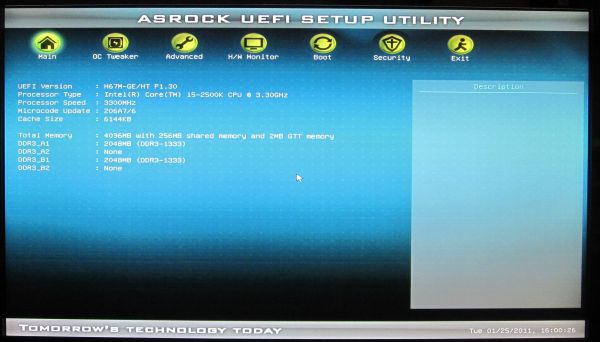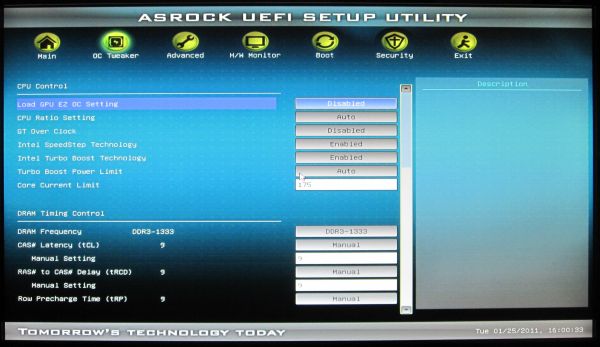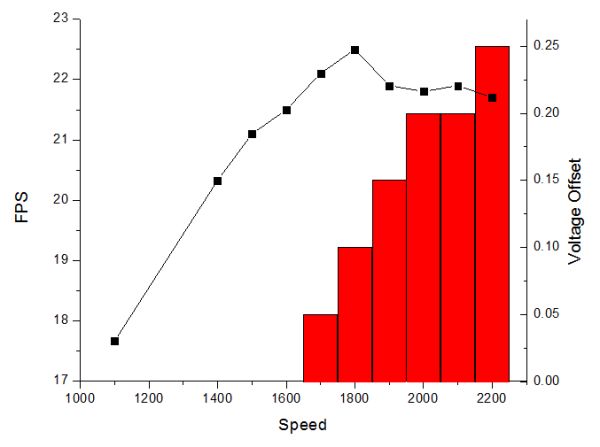H67 – A Triumvirate of Tantalizing Technology
by Ian Cutress on March 27, 2011 6:25 PM EST- Posted in
- Motherboards
- Sandy Bridge
- H67
UEFI
The ASRock UEFI we have with the H67M-GE/HT is almost identical to the P67 UEFI – a series of BIOS options on a graphical interface with use of a mouse. Alongside the booting speed benefits of the UEFI, it is pleasing to see that the graphical interface is going to become the future. The ASRock UEFI is an 8MB file, double the size of the ASUS and Gigabyte equivalents (excluding GB’s dual boot BIOS system), so there is plenty of room to grow.
As before, you will find that in the UEFI, the mouse wheel does not work. This is not a massive deal-breaker, by any means. I still prefer using the keyboard to navigate all the options, and I had no issues in using the arrow keys. You cannot use the number pad to put in voltages and such, which would be a nice touch.
The main difference between the P67 and the H67 versions of the ASRock UEFI is the overclock options which allow the GPU overclocking. The GPU EZ Settings give options between 1400 and 1600 MHz options with my 2500K, all of which work off the bat (see the overclock section below). The memory OC options are also fairly similar to the P67, except here you will only get a choice of Auto, DDR3-1000 or DDR3-1333 MHz options. All the timings are adjustable too.
Overclocking
Overclocking for the H67 series of motherboards is limited to the integrated GPU only. On our 2500K ES processor, we have Intel’s latest HD3000 integrated graphics solution, containing 12 EUs (similar to NVIDIA CUDA cores or AMD SPs) which run at 850 MHz standard and 1100 MHz turbo.
The UEFI or BIOS implementation essentially determines how you overclock the integrated graphics solution. In this instance, while the ASRock AXTU software allows changing the graphics speed, a restart is required each time it is used. Inside the UEFI itself, you have two overclocking options.
Firstly, is the predefined easy overclock option. On ASRock boards of late, I have been enjoying this option, as more often than not, just one click and it works. The ASRock H67M-GE/HT gave three options with my 2500K – 1400, 1500 and 1600 MHz. Each of these modes worked flawlessly first time, no problems. On Metro 2033 1024x768 on Normal graphics, an increase from 17.67 fps at default to 21.50 fps was seen at 1600 MHz.
The other option to overclock via the UEFI is manually increasing the speed in 50 MHz jumps, up to a 3000 MHz option. Also combined with this is an IGP voltage offset setting, allowing +0.05 V to +0.25 V in 0.05 V jumps. Below are the results from slowly increasing the MHz and increasing the voltage as required when the benchmark became unstable:
What was interesting to me was that I was able to boot easily, and the only failures came during heavy GPU usage. At 1900 MHz, the fps decreased, to which I was initially confused about. I upped the voltage further (to +0.25V) but to no avail, still got 21.90 fps. Even upping the power limits to 150 W, and the core current limit to 200 A, no change is observed. This leads me to the conclusion that at a certain point, the GPU will clock back to a safe(r) value (even if GPU MHz monitoring tools keep reporting the UEFI selected value), no matter what voltage setting is chosen, and there may be a peak in terms of performance which is fine tunable. This will be confirmed by testing other boards.
The best OC gave:
- Metro2033: 22.5 FPS, up 27.3% from 17.67 FPS
- Dirt2: 29.6 FPS, up 10.0% from 26.93 FPS



















56 Comments
View All Comments
james.jwb - Sunday, March 27, 2011 - link
"However, I remember the time when I was a scrimping student. I wanted high gaming performance at the lowest cost – if Sandy Bridge was out then, and I was specifically after the Sandy Bridge platform over anything AMD, then a H67 with an i3-2100 and the biggest graphics card I could afford would be a viable option."When I was in this position, i'd go for the cheapest CPU and overclock it so it was faster than anything on the market. I'd be surprised if this wasn't the norm for people on a tight budget.
IanCutress - Sunday, March 27, 2011 - link
My argument mainly for my comment is that the CPU is becoming less of a factor for gaming, thus shifting the focus away from a CPU OC to a large GPU. It used to be the case that the CPU made a large difference as well, but it my mind it's not that much of an issue with a strong default CPU speed and cores available. Nevertheless, the AMD + cheap tri/quad core is on the other side of the coin.Ian
slickr - Monday, March 28, 2011 - link
Intel mobos are crap. Only for overclocking and only for graphics, where is the middle?And they are too expensive, hopefully AMD wipes the floor with them with their new Buldozer platform.
Jeffs0418 - Sunday, May 22, 2016 - link
Here we are 5 years later and...Y'know I was ready to move on from my Athlon 64 x2 5000+/AM2 platform(which I liked but was marginal for modern gaming). I was stoked for a nice capable FX4100/Bulldozer platform. But after reading disappointing reviews I ended up with a Core i3 2120/Sandy Bridge and a H61 mobo. Currently running a Core i5 2500(non-k) massaged a bit to 3.9GHz on all cores with aftermarket cooling on P67 mobo. Never have used Intel integrated graphics so I couldn't care less about that. But I am glad I didn't go with Bulldozer and am comfortable enough with my current setup even now that I'm in no hurry to upgrade.omelet - Sunday, March 27, 2011 - link
Wouldn't someone wanting SB gaming on a budget be more likely to want an H61? You can get such a board from ASRock for like 60 bucks. That's $60 more you'd be able to spend on the GPU, and you'd still have every feature you need. The only real performance difference is that there's no SATA 6Gbps, but budget gamers don't have drives that need that anyway.yzkbug - Sunday, March 27, 2011 - link
Totally agree. I’m looking for a good, reliable, budget-priced motherboard for my new HTPC. Would love to see a comparison review of H61 motherboards, especially the power comparison numbers.Taft12 - Sunday, March 27, 2011 - link
I'd need to know at what point the 6 PCIE lanes on H61 begins to get in the way of the GPUs performance. Someone will surely do the testing to show us in the near future. Noticeable on, say, a 6850? Or do we need a much higher-end GPU for a bottlenect?DanNeely - Sunday, March 27, 2011 - link
The GPU would still be running on the 16 lanes from the CPU. You just have 2 less lanes for 2ndary slots and onboard devices. I don't think it's likely to be an issue except in that you're much less likely to get a second x4 slot (1/11 vs 6/16 on newegg), and the 1 H61 board that does it has legacy PCI slots for the other 2 spaces, while 5/6 H67 boards have at least 1 1x slot as well.omelet - Sunday, March 27, 2011 - link
This is very confusing. All the boards claim to have x16 slots, but they can't possibly run at x16 if none of the boards on the table even have 16 lanes. A P67 running two cards would have to run each at 4x, or even lower if there are any x1 slots on the board (as there are on most boards).It might be explained as being an x16 slot running at a lower speed, except for the fact that P67 and P55 both specify that they can run two cards at x8/x8, which can only mean that they run the x16 slots at 8 lanes each when you have two cards plugged in. That should also be impossible according to the table.
Other sources I've found on the internet seem to imply that the x16 slot on the H61 runs at full x16 speed. I think perhaps we just need some clarification on what the values on the table here mean.
ajp_anton - Sunday, March 27, 2011 - link
There are two sources for PCIe lanes. The CPUs all have x16 (only for graphics), the rest (what is shown in the table) come from the motherboard chip (H67 etc).